Onsen in Kyoto: Hotels, Private Hot Springs, Nearby Onsen Towns

Learn the best onsen hotels in Kyoto, spa facilities, and nearby hot spring resorts, from Kurama Onsen to Arima and Kinosaki. Price information is included.
How to Enjoy Onsen in Kyoto: Hotels, Day Spas, and Onsen Day Trips
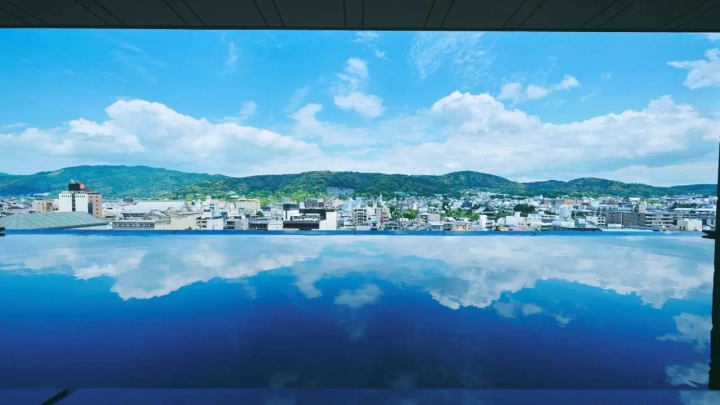
Hot spring bath at Sora Niwa Terrace Kyoto. Picture courtesy of Booking.com
Japan's volcanic landscape is home to numerous hot springs, and onsen culture is deeply rooted in the country's traditions. Due to their mineral content, hot spring baths offer various health benefits; some are known to improve blood circulation, while others are believed to have skin-beautifying effects, among other advantages.
Kyoto City is a flat area surrounded by mountains with few hot springs. However, it does feature hotels with hot spring baths that source their mineral-rich water from over 1 km underground.
The best way to enjoy onsen in Kyoto is by staying at a hotel that offers hot springs or by exploring nearby mountainous areas such as Kurama, Arashiyama, and Kameoka. You can also venture to nearby onsen towns like Arima Onsen and Kinosaki Onsen for an authentic onsen experience.
Hot Spring Facilities in Kyoto
Kyoto Hotels and Ryokan with Onsen
1. Kyoto Arashiyama Onsen Ryokan Togetsutei
2. Onyado Nono Kyoto Shichijo
3. Hotel Kuu Kyoto
4. Sora Niwa Terrace Kyoto: Onsen Baths with Scenic Views
5. Kyoto Hot Spring Hatoya Zuihoukaku Hotel: Near Kyoto Station
Day Spa and Onsen Facilities in Kyoto
6. Sagano Onsen Tenzan-no-yu: Spa Complex Near Arashiyama
7. Kyoto Arashiyama Onsen Fu Fu no Yu
8. Kyoto Takenosato Onsen Man-yo no Yu
Onsen Resorts Near Kyoto
9. Kurama Onsen
10. Kameoka
11. Arima Onsen
12. Kinosaki Onsen
Onsen Manners: How to Bathe and Tattoo-Related Tips
Kyoto Hotels and Ryokan with Onsen
1. Kyoto Arashiyama Onsen Ryokan Togetsutei

Picture courtesy of Booking.com
Kyoto Arashiyama Onsen Ryokan Togetsutei features Japanese-style rooms with private bathrooms and stunning mountain views. Located alongside the Katsura River, the hotel is just a 5-minute walk from Togetsu Bridge and Arashiyama Station.
The rooms at Onsen Ryokan Togetsutei-Syuzankaku are adorned with tatami-mat flooring and traditional futon bedding. Some accommodations even include a private outdoor hot spring bath. Guests can unwind with a soothing massage or take advantage of the sauna facilities.
2. Onyado Nono Kyoto Shichijo
Onyado Nono Kyoto Shichijo Natural Hot Spring is located just an 8-minute walk from Kyoto Station. This family-friendly hotel features rooms with an interior inspired by traditional Japanese styles and offers an on-site restaurant.
Guests can take advantage of various relaxation facilities, including hot spring baths, a sauna, and an open-air bath. For further rejuvenation, the spa and wellness center also provides massage services.
3. Hotel Kuu Kyoto
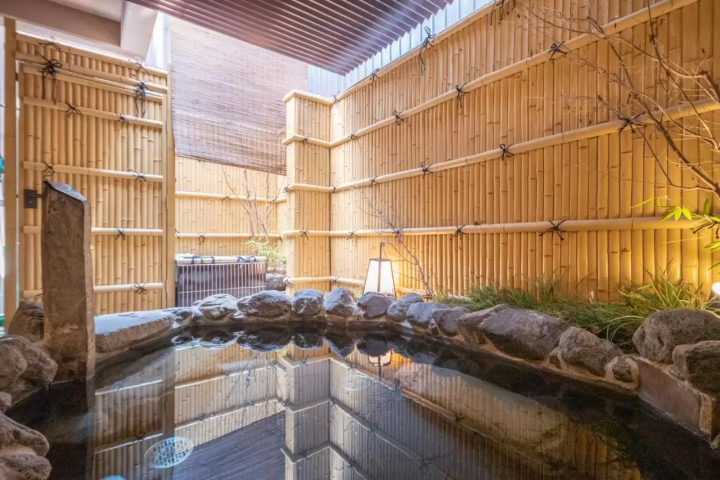
Picture courtesy of Booking.com
Hotel Kuu Kyoto, situated in the heart of Kyoto, offers family rooms designed for comfort. Guests can indulge in a sauna and experience open-air hot spring baths that reflect traditional Japanese ambiance.
The hotel provides a variety of breakfast options, including American, buffet, and Asian styles, with a child-friendly buffet specifically catering to families with young children.
4. Sora Niwa Terrace Kyoto: Onsen Baths with Scenic Views
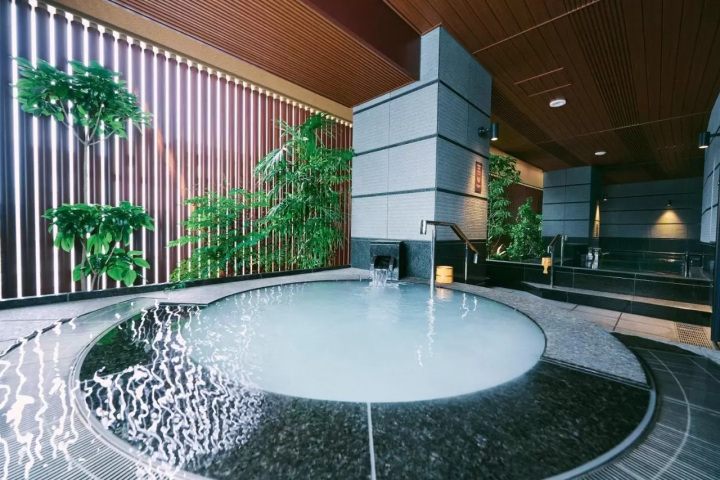
Picture courtesy of Booking.com
At Sora Niwa Terrace Kyoto, guests can unwind at the spa and wellness center, enjoy the scenic views from the rooftop terrace, and relax at the on-site bar. The public bathing area features several hot spring baths.
The hotel is conveniently located just a short walk from Gion Shijo Station and is close to popular attractions such as the Kyoto International Manga Museum and Kiyomizudera Temple.
5. Kyoto Hot Spring Hatoya Zuihoukaku Hotel: Near Kyoto Station
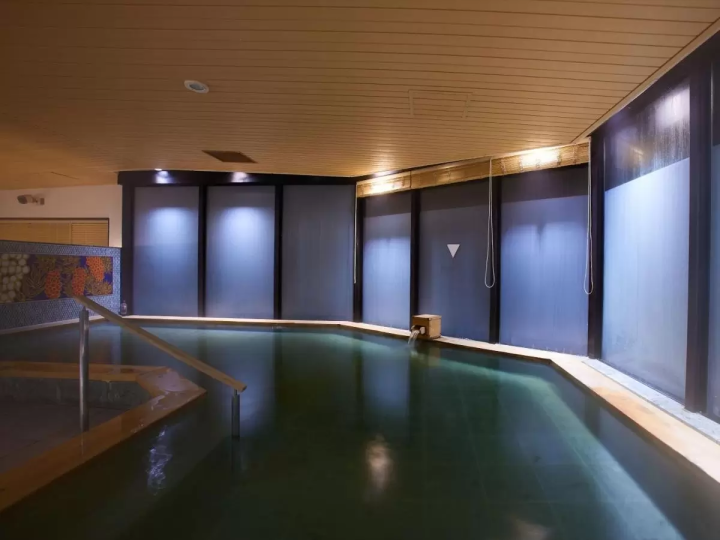
Picture courtesy of Booking.com
Kyoto Hot Spring Hatoya Zuihoukaku Hotel is located just a 5-minute walk from the Karasuma Gate of Kyoto Station and offers Japanese-style rooms with private baths.
Guests can rejuvenate in the public indoor and outdoor hot spring baths situated on the top floor. Some of their hot spring baths have been praised for their skin-beautifying properties.
The hotel's prime location places it conveniently near Kyoto Station, with Kyoto Tower only a 3-minute walk away.
Day Spa and Onsen Facilities in Kyoto
Sagano Onsen Tenzan-no-yu: Spa Complex Near Arashiyama
Sagano Onsen Tenzan-no-yu is a spa complex featuring a variety of indoor and outdoor hot spring baths, along with body treatment and massage facilities.
The hot spring water at Tenzan no Yu is classified as a sodium and calcium chloride spring. The sodium carboxylate component provides effects similar to soap by removing skin impurities. Its emulsifying properties also help to moisturize the skin. The calcium salt offers a texture akin to that of baby powder, leaving the skin feeling silky smooth.
Situated in the serene mountains of Sagano near Arashiyama, the facility does not provide lodging and is primarily designed for guests seeking to relax in the baths or partake in wellness treatments.
Tenzan no Yu can be accessed in a 3-minute walk from Arisugawa Station on the Randen Arashiyama Line, a tram line.
Please note that Tenzan no Yu cannot be used by persons who have tattoos or body art.
Sagano Onsen Tenzan-no-yu
Location: Map
Business hours: 10:00 - 0:00 (*last entry at 23:00)
Fees: Adults 1,200 yen on weekdays/1,300 yen on weekends, Children 550 yen
Website: https://www.ndg.jp/tenzan/en/
Kyoto Arashiyama Onsen Fu Fu no Yu
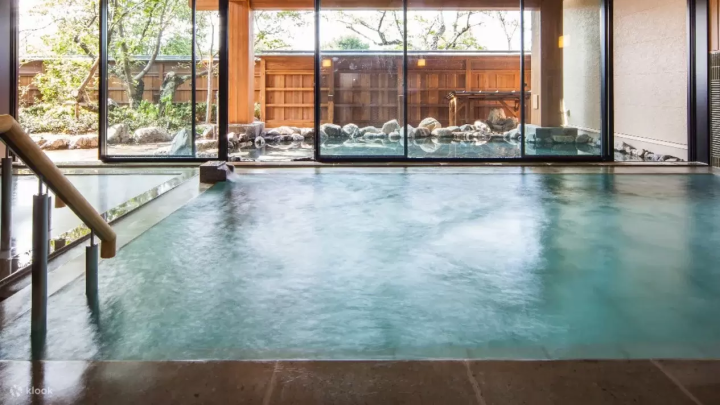
Picture courtesy of Klook
Fu Fu no Yu is a hot spring facility located just a 1-minute walk away from the Hankyu Arashiyama Station and operated by dormy hotels & resorts.
The facility has several indoor and outdoor hot spring bathing facilities, including a dry sauna, a misty sauna, and a silky hot spring bath praised for its skin-beautifying properties.
Please note that Fu Fu no Yu does not permit entry to individuals with tattoos or body art, even if they are covered with tattoo seals.
Kyoto Arashiyama Onsen Fu Fu no Yu
Location: Map
Business hours: 12:00 - 22:00
Fees: Adults 1,100 yen on weekdays/1,300 yen on weekends, Children 600 yen
Website: https://dormy-hotels.com/spa/fufu/
Kyoto Takenosato Onsen Man-yo no Yu
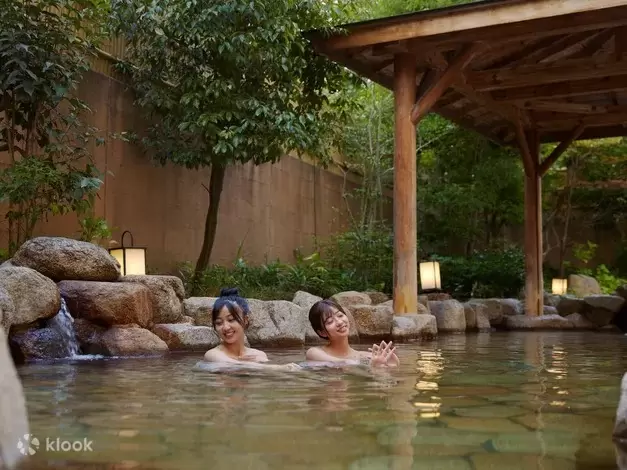
Picture courtesy of Klook
Kyoto Takenosato Onsen Man-yo no Yu, situated in Takenosato, an area renowned for its lush bamboo groves, offers two types of hot springs: a simple hot spring and a sodium bicarbonate hot spring. Both are celebrated as "hot springs of beauty," known for making the skin smooth and silky.
This facility is open 24 hours a day and includes a bedrock bath, massage services, a restaurant, and a rest space that is ideal for taking naps. Man-yo no Yu also offers accommodation in Japanese-style rooms.
The easiest way to access this onsen facility is by taxi from Hankyu Rakusaiguchi Station, with the ride taking approximately 7 minutes and costing around 1,200 yen.
Please note that the facility cannot be used by persons with tattoos, body art, or tattoo seals.
Kyoto Takenosato Onsen Man-yo no Yu
Location: Map
Business hours: open 24 hours
Fees: Adults 2,530 yen, Children 1,270 yen, Infants 990 yen
Website: https://www.manyo.co.jp/kyoto/language/
Onsen Resorts Near Kyoto
Kurama Onsen
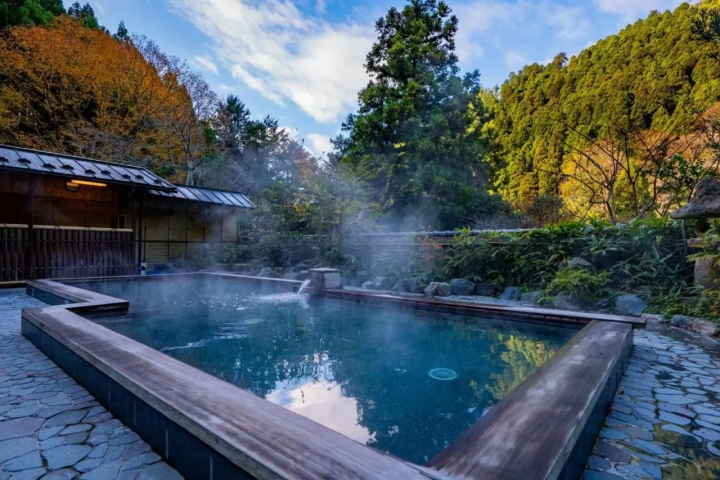
Picture courtesy of Booking.com
Kurama is a picturesque mountainous area near Kyoto, celebrated for its hiking trails and spiritual sites such as Kuramadera Temple and Kifune Shrine.
It is also home to one of Kyoto's finest hot spring facilities, Kurama Onsen, which features multiple hot spring baths, a sauna, and restaurants. Kurama Onsen is a great destination for a day of relaxation and wellness in the heart of nature.
While the facility offers ryokan-style accommodation, it is accessible to non-staying guests who wish to enjoy the baths. The accommodations at Kurama Onsen include a garden, a shared lounge, and a terrace, with rooms that provide beautiful views of the mountains.
Kameoka
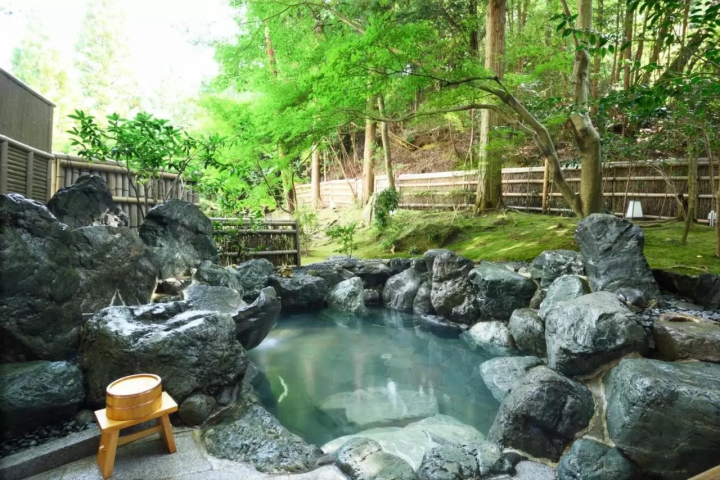
Picture courtesy of Booking.com
Kameoka is a city in Kyoto Prefecture, known for its rich natural scenery and scenic mountain views. This area also features several hot spring facilities and onsen ryokans (Japanese inns with hot spring baths).
A recommended option is Kyo Yunohana Resort Suisen, where guests can enjoy both indoor and outdoor hot spring baths, traditional Japanese-style accommodations, and exquisite ryokan cuisine that highlights the finest ingredients and culinary traditions of Kyoto.
Arima Onsen
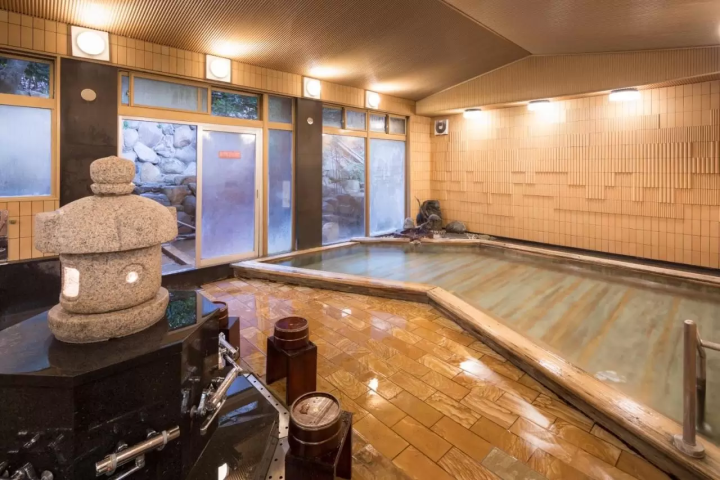
Picture courtesy of Booking.com
Arima Onsen is a famous hot spring resort located in the Hyogo Prefecture of Japan, near the city of Kobe. Renowned for its therapeutic waters, Arima Onsen boasts two main types of mineral-rich springs: Kinzuki (gold spring), which is known for its reddish-brown color due to its high iron content, and Ginzuki (silver spring), which is clear and contains radium and carbonate.
Arima Onsen is said to be the oldest hot spring town in Japan, with roots dating back over a thousand years, and it has been a favored retreat for both locals and travelers.
In addition to its hot springs, Arima Onsen offers traditional ryokan accommodations, beautiful scenery, and nearby attractions such as hiking trails and historic temples. The onsen town has many cozy cafes with a relaxing atmosphere where you can enjoy local food and sweets.
We recommend staying at a Japanese inn such as Arima Onsen Gekkoen Yugetsusanso, which features a hot spring bath, a spa and wellness center, a sauna, an open-air bath, and a restaurant.
The easiest way to reach Arima Onsen from Kyoto is by taking a bus from Kyoto Station. A ride costs between 1,650 yen and 1,850 yen depending on the time of the day.
Read also
Kinosaki Onsen
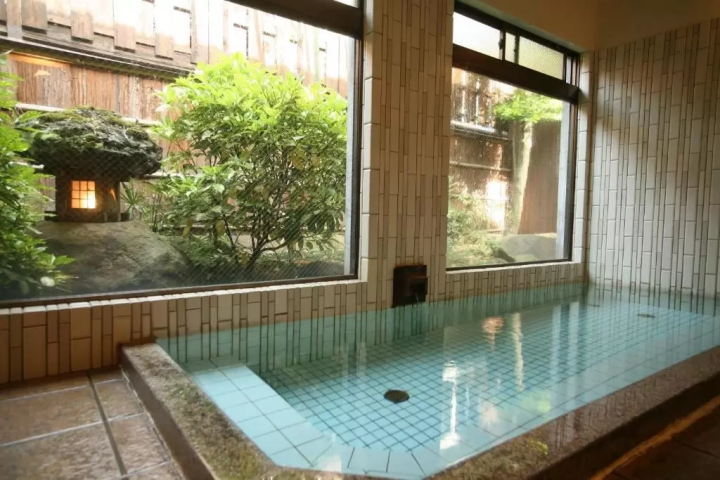
Picture courtesy of Booking.com
Kinosaki Onsen is a picturesque hot spring town located in Hyogo Prefecture, Japan. Renowned for its eight public onsen (hot spring baths), Kinosaki Onsen offers visitors a unique experience of traditional Japanese bathing culture.
The town is known for its charming, historic streets lined with willow trees and traditional ryokan (inns), where guests can stay and enjoy the local hot springs.
Kinosaki Onsen is also one of the few hot spring towns where all the public baths are tattoo-friendly.
We recommend staying at a Japanese inn like Kinosaki Onsen Kawaguchiya Honkan, which offers stylish Japanse rooms with modern amenities in addition to excellent hot spring baths.
Kinosaki Onsen Station can be easily reached by direct train from Kyoto Station.
Onsen Manners: How to Bathe and Tattoo-Related Tips
Regarding how to use a hot spring facility in Japan, here's a step-by-step guide.
Upon entering the onsen, you’ll find a designated area for shoes where you should remove your footwear and place it in the provided lockers. After paying the entry fee, proceed to the changing room, where it is customary to undress completely before entering the bathing area, as towels should not be taken into the baths.
Before soaking in the bath, thoroughly wash your body at the washing stations using the provided stools, portable shower heads, and toiletries. Once clean, enter the hot spring bath slowly to acclimatize to the temperature, keeping noise to a minimum.
After bathing, rinse off again with clean water to remove any minerals, then return to the changing area to dry off and get dressed. Most hot spring facilities offer amenities for skin and hair care that are included in the fee, so feel free to use them.
Check the article linked below for details:
In Kyoto, most hot spring facilities do not permit customers with tattoos or body art, with regulations often being stricter than those in Tokyo. It’s important to understand that tattoos have a complex history in Japan, historically associated with gangs and antisocial behavior.
For those with body art, we recommend visiting tattoo-friendly hot spring facilities, such as Kinosaki Onsen, where the entire hot spring town welcomes customers with tattoos. If needed, consider covering your tattoos with tattoo seals.
Read also
Main image courtesy of Booking.com
Ramona, English content editor at MATCHA since 2016, has been practicing ikebana flower arrangement (Ikenobo School) and tea ceremony (Omote Senke) since 2012. She arrived in Japan in 2012 as a graduate student with a focus on Japanese literature and performing arts. As a travel editor and writer, Ramona has visited and documented 40 of Japan's prefectures with a focus on art, history, traditional Japanese crafts, and performing arts.































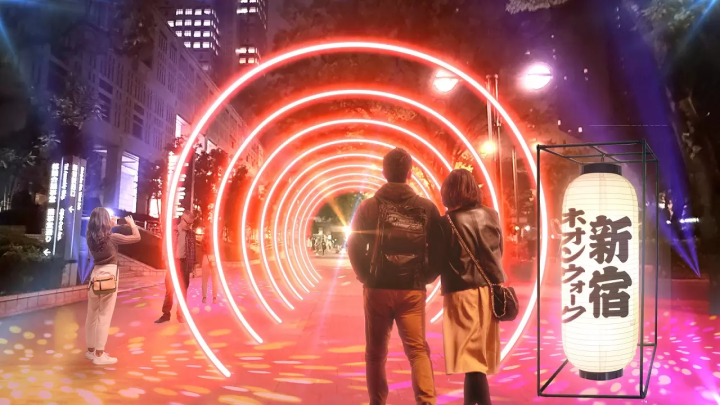
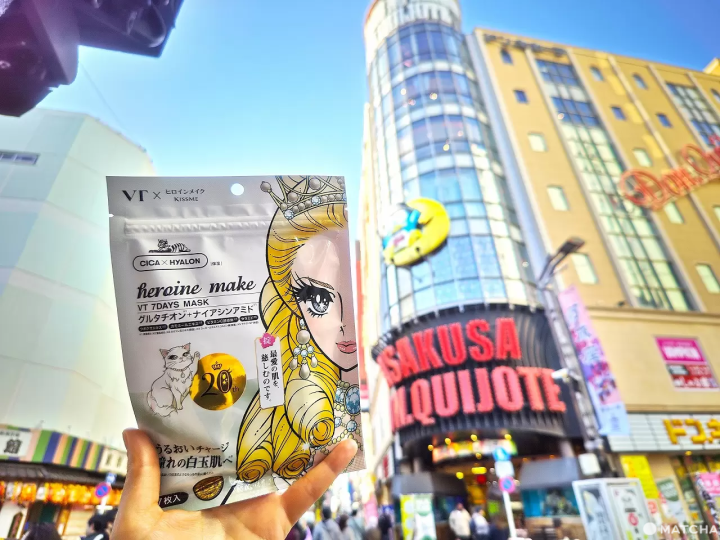


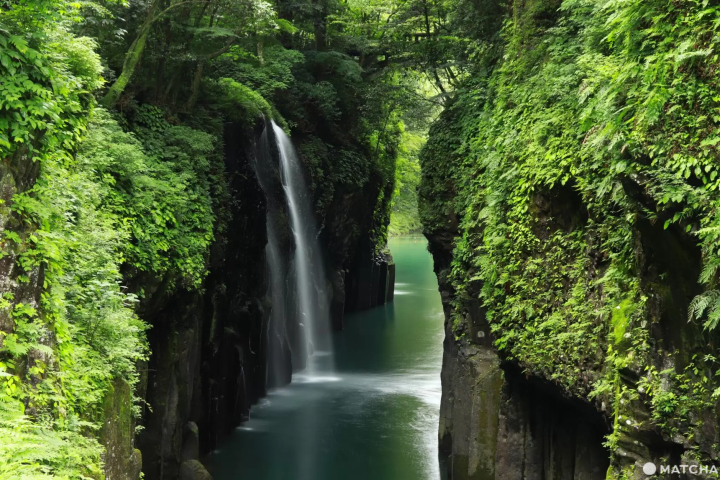





![[JR KYUSHU HOTEL Blossom Oita] A hotel directly connected to Oita Station - A comprehensive guide to access!](https://resources.matcha-jp.com/resize/720x2000/2025/10/23-247814.webp)
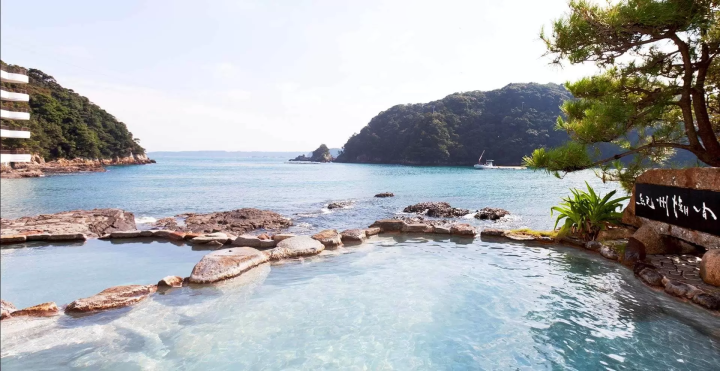
![Deep dive into Japanese brands! A tour of famous leather shoe stores with GENSEI & Nin [Harta Edition]](https://resources.matcha-jp.com/resize/720x2000/2025/12/18-253277.webp)
